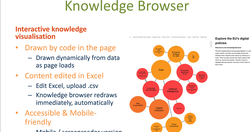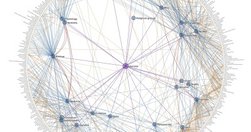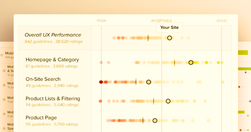Relevant Overviews
- Bluesky and the ATmosphere
- Communication Strategy
- Content Strategy
- Knowledge4Policy
- Fediverse
- Online Strategy
- Online Community Management
- Social Media Strategy
- Content Creation & Marketing
- Online Architecture
- Digital Transformation
- Change & Project Management
- Thinking tools
- Zettelkasten
- Learning from Andy Matuschak
- Personal Productivity
- Innovation Strategy
- Surveillance Capitalism, Social media and Polarisation (Overview)
- Communications Tactics
- Psychology
- Social Web
- Media
- Politics
- Communications Strategy
- Science&Technology
- Business
Overview: Online Architecture
Probably the most common reason organisations contact me is to get help with their internal and external information architecture.
I usually find, however, that they first need to find a clear consensus on their communication strategy, content strategy and online strategy. Once that's done, I deliver a document which both you and your developers can understand, including some or all of the following:
- highly detailed sitemaps: internal intranets, external websites, knowledgebases, and the information flows between them
- mission statements for principal site chapters, features and content types
- business requirements for any revised or new features
- wireframes, allowing both you and your developers to envision how the result will look.
The aim is to deliver something detailed enough for professional developers and designers to give you a concrete quote, but not so technical that noone else understands what they're building.
I can then work with them to deliver it, or assemble a team and manage the site build for you.
Check out some of my firsts and best practices, or just get in touch.
More services: start with Communication strategy.
Relevant resources
Further progress by Bluesky on "improving the quality of replies and making conversations feel more personal, constructive, and in your control":identifying social neighbourhoods "the people you already interact with or would likely enjoy knowing" and prioritising conversations in thema dislike option to help personalise Discover & other feeds. "D…
A short (true) story about a designer running amok, mistaking productivity for quality. He "pumped out more screens in a day than more experienced designers would in a week. Leadership adored him. They saw the speed... mistook it for value creation. ... What started as impressive momentum became an unmanageable flood... no critique, no usability …

OpenSocial's AI integration provides "a unique AI model trained on your specific platform data... Gaia Chatbot transforms how you access information, making every interaction a seamless exchange of knowledge discovery".Works with all AI providersautomatic tagging and classification"adapts in real time to user ... individualized community journey"A…

"How open source projects can balance Makers and Takers: lessons from Drupal's contribution credit system" by the founder of Drupal, in reaction to the Wordpress/WP Engine debacle, tackling "two key challenges that many open source projects face" and which could impede the development of opensource:"The imbalance between major contributors and tho…
"Transformation Maps... help users to explore and make sense of the complex and interlinked forces ...transforming economies, industries and global issues... insights written by experts along with machine-curated content... allows users to visualise and understand more than 250 topics and the connections and inter-dependencies between them... to s…

how "Mastodon fits into the much larger concept of the Fediverse... visualisation ... many different use-cases and benefits of different services".Good intro to the Fediverse as a whole, plus the visualisation in png & pdf, and some Q&As covering multiple accounts ("a user preference"), Nextcloud (adding ActivityPub end 2022). Wordpress & Drupal (…

4 ways Mastodon doesn't optimise for enragement.On Mastodon’s "home timeline... posts don’t have metrics ... you have to click through ... makes you judge a post first by its content, rather than the score attached to it... the whole dynamic [being "ratioed"] doesn’t exist... leads to more thoughtful engagement rather than ... Liking every post by…
A new app and protocol to give "people full control over their interest graphs ... there was no standard, decentralized repository for online media and its derivatives... culture that is readily available for anyone to annotate, remix, compile, create new editions of or link together in archives. Mediagraph [protocol] will let developers build on …
Via FotL I discover "Canonical Debate Lab (CDL)... researchers, developers, and system thinkers who have independently been working on collective intelligence systems for several years... goal is to aggregate contributions of diverse stakeholders into a unified information space, which can be accessed through multiple views... tailored to a specif…

New Public "spent two years reviewing the literature and talked to over 100 experts from disciplines ranging from social psychology to urban planning about the qualities of flourishing public, or semi-public, spaces" for their Building better digital public spaces report. The goal: "to support engineers, designers and builders who want to create m…

Systems with Design from Trust: assume most (not all) people have good intent."initially feel counterintuitive, even risky...social: they rely on human relationships. appealing: once you wrap your head around them, you want more."The discomfort is a symptom of how today's default setting is mistrust: "we’ve internalized the assumption that humans …

Good starting point on pattern languages, ends with useful links.As a definition of what a pattern is: "a proven solution to a problem in a context. Each one documents a reusable solution, encapsulates knowledge about successful practices, and provides information about its usefulness and tradeoffs... Connected sets of interrelated patterns build…

An interactive knowledge visualisation providing a graphical overview of interrelated online concepts, edited dynamically with an Excel file. Featuring an accessible version driven by the same content.
We've tweaked the navigation phrase so that the default is to show "All the" resources on your home page, rather than just "The Best". More tweaks are on the way.
Having fun using Andy Matuschak's wonderful site to explore his innovative ideas on note-taking, zettelkasten, writing, etc. This link opens a number of his interrelated notes, displayed horizontally using his innovative 'stacked notes' information architecture.Key ideas from this stack:the importance of 'task division' in knowledge work: instead …
Andy Matuschak's working notes "are mostly written for myself: they’re roughly my thinking environment... But I’m sharing them publicly as an experiment ... [see] Work with the garage door up... Write notes for yourself by default, disregarding audience)... there’s no index or navigational aids: you’ll need to follow a link to some starting point.…

"User friction ... prevents a user from accomplishing a goal in your product... three levels: interaction friction, cognitive friction, and emotional friction"Interaction friction: do usability testing."When cognitive load is high ... there is significant cognitive friction ... encompasses all aspects of the experience that result in mental effor…

Approach to visualising Wikipedia category pages and their interconnections.

Privacy Zuckering... when “you are tricked into publicly sharing more information about yourself than you really intended to... Facebook... paid a $5 billion fine for making “deceptive claims about consumers’ ability to control the privacy of their personal data.” ... “dark patterns,” ... particularly insidious “when you’re deciding what privac…

how Roam’s first prophet organizes his life... I think of Roam as a low friction database oriented around tying ideas together over time... other note-taking app... work kind of like a filing cabinet... each project I do gets its own page in Roam... at least two tags to it: #Projects... #Active ... I’m actively working on it... automatically …

There are about 175 known cognitive biases to date. I will share some of the ones that I think are the most significant for designers... It is important that we not learn about biases to simply point out errors in others... we [need] to spot errors in our own thinking ...confirmation bias ... conservatism bias ... [influence us] to select and use …

to investigate ... notion that websites are starting to look the same ... data mining ... scrutinized nearly 200,000 images across 10,000 websites... of the Russell 1000, the top U.S. businesses by market capitalization ... Alexa’s 500 most trafficked sites... sites nominated for Webby Awards ... how many pixel-by-pixel edits ... to transform colo…

If you’re a User Researcher ... Baymard can probably provide you some value ... an “independent web usability research institute”... founded on the central thesis that design decisions are often made subjectively ... a more evidence-based approach is possible...Baymard sells research ... based on tens of thousands of hours of their own in-house us…

In this era... design was the product. Whatever else you might be buying, you were buying design, and all the design looked the same... Ever since modernism brought industry into design, tastes have cycled ... A forward-looking, high-tech style obsessed with mass commercial appeal ... to one that’s backward-looking, handmade, authenticity-obsessed…

Our scientists are publishing sophisticated data visualisations for policymakers to use. But are policymakers using them? ... I interview Annie White and Nil Tuzcu of Harvard’s Growth Lab about their use of data visualisations for policymaking... summarise the resulting guidance we’re giving Knowledge4Policy publishers.

Most cookie consent pop-ups ... are likely to be flouting regional privacy laws... another piece of research ... also concluded a majority of ... cookie notices offer no meaningful choice to Europe’s Internet users — even though EU law requires one...if it’s configured to contain pre-ticked boxes that opt users into sharing data by default — requi…
Some sites are a victim of their own initial success. A decade after launching, an EC community platform was struggling to remain relevant. Over the intervening years it had offered a flexible, powerful publishing solution to many different parts of the EC...

some practical tips on how to carry out moderated think-aloud usability testing. It’s based on what I’ve learnt from academic research and from practical experience, both inside and outside government.

free online ratings are less trustworthy than those that have some cost to them... In ecology, costly signaling theory argues that displays that “cost” more — like elaborate peacock tails, or strenuous displays of hunger from baby birds — are more likely to reflect reality... making rating goods or services as easy as possible... is counterproduct…
Relevant Overviews
- Bluesky and the ATmosphere
- Communication Strategy
- Content Strategy
- Knowledge4Policy
- Fediverse
- Online Strategy
- Online Community Management
- Social Media Strategy
- Content Creation & Marketing
- Online Architecture
- Digital Transformation
- Change & Project Management
- Thinking tools
- Zettelkasten
- Learning from Andy Matuschak
- Personal Productivity
- Innovation Strategy
- Surveillance Capitalism, Social media and Polarisation (Overview)
- Communications Tactics
- Psychology
- Social Web
- Media
- Politics
- Communications Strategy
- Science&Technology
- Business